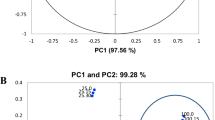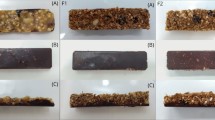Abstract
Watermelon rind powder (WRP) is a rich source of dietary fiber and bioactive compounds, hence it could be used in the development of functional foods such as cookies. Different replacement levels of wheat flour with either WRP or hi-maize starch (HMS) (10-30%) on the quality of the cookies made were studied. The dietary fiber content in the cookies increased with incorporation of increasing level of either WRP or HMS. Increasing the proportion of the WRP in the cookie making resulted in an increase in the total phenolic content, 2,2-diphenyl-1-picrylhydrazyl radical scavenging activity, and the ferric reducing antioxidant power. Using up to 20% of WRP and 30% of HMS in the cookie making promotes: increase in dietary fiber, decrease in predicted glycemic index to medium (for WRP) and low (for HMS) levels, and improving the antioxidant activity. These changes still produce an acceptable cookie.
Similar content being viewed by others
References
Sozer N, Cicerelli L, Heinio RL, Poutanen K. Effect of wheat bran addition on in vitro starch digestibility, physico-mechanical and sensory properties of biscuits. J. Cereal Sci. 60: 105–113 (2014)
Menon R, Padmaja G, Sajeev MS. Cooking behavior and starch digestibility of NURIOSE (resistant starch) enriched noodles from sweet potato flour and starch. Food Chem. 162: 217–223 (2015)
Agama-Acecedo E, Islas-Hernandez JJ, Pacheco-Vargas GP, Osorio-Diaz P, Bello-Perez LA. Starch digestibility and glycemic index of cookies partially substituted with unripe banana flour. LWT-Food Sci. Technol. 46: 177–182 (2012)
Kim Y, Kim Y, Bae IN, Lee GH, Lee S. P reparation of d ietary fiber-enriched materials from preharvest dropped apples and their utilization as a high-fiber flour substitute. J. Sci. Food Agr. 93: 1974–1978 (2013)
Srivastava P, Indrani D, Singh RP. Effect of dried pomegranate (Punica granatum) peel powder (DPPP) on textural, organoleptic and nutritional characteristics of biscuits. Int. J. Food Sci. Nutr. 65: 827–833 (2014)
Sharma P, Velu V, Indrani D, Singh RP. Effect of dried guduchi (Tinospora cordifolia) leaf powder on rheological, organoleptic and nutritional characteristics of cookies. Food Res. Int. 50: 704–709 (2013)
Ahmad M, Baba WN, Wani TA, Gani A, Gani A, Shah U, Wani SM, Masoodi FA. Effect of green tea powder on thermal, rheological and functional properties of wheat flour and physical, nutraceutical and sensory analysis of cookies. J. Food Sci. Technol. 52: 5799–5807 (2015)
Chung HJ, Cho A, Lim ST. Utilization of germinated and heat-moisture treated brown rices in sugar-snap cookies. LWT-Food Sci. Technol. 57: 260–266 (2014)
Sangeetha AV, Mahadevamma S, Begum K, Sudha ML. Influence of processed sugarcane bagasse on the microbial, nutritional, rheological and quality characteristics of biscuits. Int. J. Food Sci. Nutr. 65: 457–464 (2011)
Raymundo A, Fradinho P, Nunes MC. Effect of psyllium fiber content on the textural and rheological characteristics of biscuit and biscuit dough. Bioact. Carbohydr. Diet. Fibre 3: 96–105 (2014)
Al-Sayed HMA, Ahmed AR. Utilization of watermelon rinds and sharlyn melon peels as a natural source of dietary fiber and antioxidants in cake. Ann. Agr. Sci. 58: 83–95 (2013)
AOAC. Official Methods of Analysis of AOAC Intl, 13th ed. Method 930.04, 930.05, 979.09, 957.13. Association of Official Analytical Chemists, Washington, DC, USA (1996)
Ameur LA, Mathieu O, Lalanne V, Trystram G, Birlouez-Aragon I. Comparison of the effects of sucrose and hexose on furfural formation and browning in cookies baked at different temperatures. Food Chem. 101: 1407–1416 (2007)
Ajila CM, Leelavathi K, Rao UJSP. Improvement of dietary fiber content and antioxidant properties in soft dough biscuits with the incorporation of mango peel powder. J. Cereal Sci. 48: 319–326 (2008)
Choudhury M, Badwaik LS, Borah PK, Sit N, Deka SC. Influence of bamboo shoot powder fortification on physicochemical, textural and organoleptic characteristic of biscuits. J. Food Sci. Technol. 52: 6742–6748 (2015)
Benzie IFF, Strain JJ. The ferric reducing ability of plasma (FRAP) as a measure of antioxidant power: the FRAP assay. Anal. Biochem. 239: 70–76 (1996)
Sharma P, Gujral HS. Cookie making behavior of wheat-barely flour blends and effects on antioxidant properties. LWT-Food Sci. Technol. 56: 301–307 (2014)
Englyst HN, Kingman SM, Cummings JH. Classification and measurement of nutritionally important starch fractions. Eur J. Clin. Nutr. 46: S33–S50 (1992)
Goni I, Garcia D, Saura-Calixto F. A starch hydrolysis procedure to estimate glycemic index. Nutr Res. 17: 427–437 (1997)
Sudha ML, Vetrimani R, Leelavathi K. Influence of fiber from different cereals on the rheological characteristics of wheat flour dough and on biscuit quality. Food Chem. 100: 1365–1370 (2007)
Becker FS, Damiani C, Melo AAM, Borges PRS, Boas EVBV. Incorporation of Buriti endocarp flour in gluten free whole cookies as potential source of dietery fiber. Plant Food Hum. Nutr. 69: 344–350 (2014)
Kaur M, Sandhu KS, Arora A, Sharma A. Gluten free biscuits prepared from buckwheat flour incorporation of various gums: Physicochemical and sensory properties. LWT-Food Sci. Technol. 62: 628–632 (2015)
Yalegama LLWC, Karunratane DN, Sivakanesan R, Jayasekara C. Chemical and functional properties of fiber concentrates obtained from by-products of coconut kernel. Food Chem 141: 124–130 (2013)
Dachana KB, Rajiv J, Indrani D, Prakash J. Effect of dried Moringa (Moringa Oleifera Lam) leaves on rheological, microstructural, nutritional, textural and organoleptic characteristics of cookies. J. Food Quality 33: 660–667 (2010)
Mais A, Brennan CS. Characterization of flour, starch and fiber obtained from sweet potato (kumara) tubers, and their utilization in biscuit production. Int. J. Food Sci. Tech. 43: 373–379 (2008)
Ogunsina BS, Radha C, Indrani D. Quality characteristics of bread and cookies enriched with debittered Moringa oleifera seed flour. Int. J. Food Sci. Nutr. 62: 185–194 (2011)
Chevallier S, Colonna P, Lourdin D. Contribution of major ingredients during baking of biscuit dough systems. J. Cereal Sci. 31: 241–252 (2010)
Baixauli R, Salvador A, Fiszman SM. Textural and color changes during storage and sensory shelf life of muffins containing resistant starch. Eur. Food Res. Technol. 226: 523–530 (2008)
Laguna L, Salvador A, Sanz T, Fiszman SM. Performance of a resistant starch rich ingredient in the baking and eating quality of short-dough biscuits. LWTFood Sci. Technol. 44: 737–746 (2011)
Rajiv J, Soumya C. Chemical, rheological and nutritional qualities of sugar snap cookies as influenced by the addition of multigrain. J. Food Meas. Char. 9: 135–142 (2014)
Drisya CR, Swetha BG, Velu V, Indrani D, Singh RP. Effect of dried Murraya koenigii leaves on nutritional, textural and organoleptic characteristics of cookies. J. Food Sci Technol. 52: 500–506 (2015)
McWatters KH. Cookie baking properties of defatted peanut, soybean and field pea flours. Cereal Chem. 55: 853–863 (1978)
Manzocco LS, Calligaris S, Mastrocola D, Nicoli MC, Lerici CR. Review of nonenzymatic browning and antioxidant capacity in processed foods. Trends Food Sci. Tech. 11: 340–346 (2000)
Soong YY, Tan SP, Leong LP, Henry JK. Total antioxidant capacity and starch digestibility of muffins baked with rice, wheat, oat, corn and barley flour. Food Chem. 164: 462–469 (2014)
Regand A, Chowdhury Z, Tosh SM, Wolever TMS, Wood P. The molecular weight, solubility and viscosity of oat beta-glucan affect human glycemic response by modifying starch digestibility. Food Chem. 129: 297–304 (2011)
Author information
Authors and Affiliations
Corresponding author
Rights and permissions
About this article
Cite this article
Naknaen, P., Itthisoponkul, T., Sondee, A. et al. Utilization of watermelon rind waste as a potential source of dietary fiber to improve health promoting properties and reduce glycemic index for cookie making. Food Sci Biotechnol 25, 415–424 (2016). https://doi.org/10.1007/s10068-016-0057-z
Received:
Revised:
Accepted:
Published:
Issue Date:
DOI: https://doi.org/10.1007/s10068-016-0057-z




